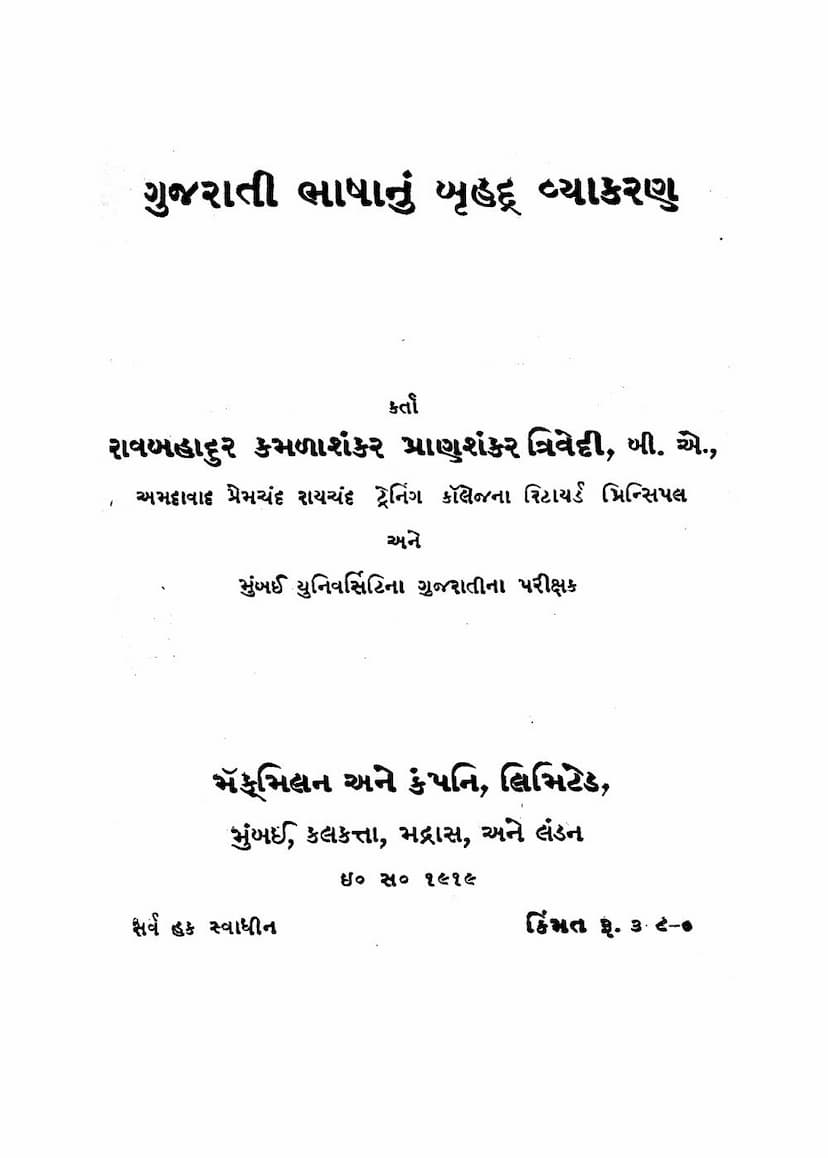Gujarati Bhashanu Bruhad Vyakaran
Added to library: September 1, 2025

Summary
Here's a comprehensive summary of the Jain text "Gujarati Bhashanu Bruhad Vyakaran" by Ravbahadur Kamlashankar Pranshankar Trivedi, based on the provided pages:
Gujarati Bhashanu Bruhad Vyakaran (A Comprehensive Grammar of the Gujarati Language)
- Author: Ravbahadur Kamlashankar Pranshankar Trivedi, retired Principal of Premchand Roychand Training College, Bombay, and Examiner in Gujarati for Bombay University.
- Publisher: Macmillan and Company Limited, Bombay, Calcutta, Madras, and London.
- Publication Year: 1919.
- Overall Scope: This is a monumental and exhaustive work on Gujarati grammar, presented as the culmination of the author's earlier elementary grammar. It aims to provide a scholarly and comprehensive treatment of the subject, incorporating the latest philological research and a comparative view of Indo-Aryan languages.
Key Features and Content:
-
History of Gujarati Language: The book delves into the origins and evolution of the Gujarati language, tracing its lineage from Nagari Apabhramśa and what Dr. Tessitori calls Old Western Rajasthani. It provides numerous illustrations from old works to demonstrate the language's construction, vocabulary, and word derivation.
-
Comprehensive Grammatical Treatment: The grammar covers all aspects of the Gujarati language, including:
- Phonetics (Pronunciation): Detailed discussion on the origin and development of language, articulation of sounds, vocal organs, and the science of pronunciation.
- Etymology: The derivation and history of words, including influences from Persian and Arabic.
- Morphology (Accidence): Treatment of parts of speech – nouns (gender, number, case), pronouns, adjectives, verbs (tenses, moods, conjugations), indeclinables (nipats, upasargas, purvagas), and compound words (samasa).
- Syntax: Sentence structure, analysis, and the relationship between words.
- Punctuation: The use of punctuation marks.
- Philology and Linguistics: Discussions on the science of language, its origins, classification, and development.
- Philological and Etymological Portions: These are printed in smaller type for those who wish to delve deeper.
-
Comparative Study: The work takes a comparative approach to Indo-Aryan vernaculars, highlighting necessary comparisons for a thorough understanding of Gujarati.
-
Addressal of Controversial Issues: It tackles the "thorny question" of word separation and Gujarati spelling, offering practical and expedient solutions.
-
Poetics and Literary Criticism: The book extends to the subject of Poetics (Kavya Shastra), covering Rasa, Bhava, Rasabhāsa, Guṇa, Dosha, Alankaras, and varieties of composition, including Nataka and its Sandhis. It also offers literary criticism on Gujarati prose and poetry, pointing out common faults.
-
Classification of Types: The author has utilized various type sizes (small, medial, and large) to cater to different levels of students, allowing for omission of less crucial details based on individual requirements.
-
Extensive Bibliography: A list of consulted books is appended, indicating the author's rigorous research methodology. This includes works by prominent linguists like J. Beames, A.F.R. Hoernle, R.G. Bhandarkar, and G.A. Grierson, as well as Sanskrit and Prākṛt grammars and works on Old Gujarati literature.
-
Detailed Table of Contents (Anukramanika): The detailed table of contents reveals the vastness of the coverage, spanning 40 chapters that systematically explore every facet of Gujarati grammar and linguistics.
Specific Topics Covered in Detail (as seen in the table of contents):
- Chapter 1-3: Origins and development of language, language classification (morphological and historical).
- Chapter 4: History of the Gujarati language, tracing its evolution from Sanskrit, Prakrit, and Apabhramśa, with extensive examples from various centuries.
- Chapter 5: The importance and purpose of grammar (Vyakaran).
- Chapters 6-11: Phonetics (Shiksha), word-power (Abhidha, Lakshana, Vyanjana), semantic changes, word division, noun types, and gender.
- Chapters 12-21: Number, case (Vibhakti), Karkas (semantic role), pronouns, adjectives, verbs (types, roots, krudanta), tenses, and voice (Prayog).
- Chapter 22: Ni'pat (indeclinables), Upasarga (prefixes), and Purvaga.
- Chapter 23: Avyaya (indeclinables) and their types.
- Chapters 24-25: Sandhi (euphony) – types and rules.
- Chapter 26: Samasa (compounds) – types and examples.
- Chapters 27-28: Taddhita and Krut pratyayas (derivational suffixes).
- Chapter 29: The position of Gujarati within the context of Hind-Aryan Prakrit languages.
- Chapters 30-31: Etymology (Shabd-siddhi), focusing on changes in sounds, vowel and consonant changes, and analysis of Tadbhava words. Word repetition (Dvirukta Shabda).
- Chapters 32-35: Syntax (Padavinyas), sentence analysis (Vakyarth), and punctuation (Viramchinha).
- Chapters 36-38: Style (Bhasha Shaili), language purification (Bhasha Shuddhi), and rules for word separation and spelling.
- Chapters 39-40: Poetics (Prabandh), covering Kavya Vichar (elements of poetry like Rasa, Guna, Dosha, Alankaras, Riti, Vrutti) and explaining various poetic meters (Vritta Vichar).
Conclusion:
"Gujarati Bhashanu Bruhad Vyakaran" stands as a seminal work in Gujarati linguistics, offering an unparalleled depth and breadth of coverage. Ravbahadur Kamlashankar Pranshankar Trivedi's meticulous research, historical perspective, and comparative linguistic analysis make this volume an invaluable resource for students, scholars, and anyone interested in the intricacies of the Gujarati language. The author's dedication to providing a comprehensive and scholarly grammar is evident in every aspect of this extensive work.